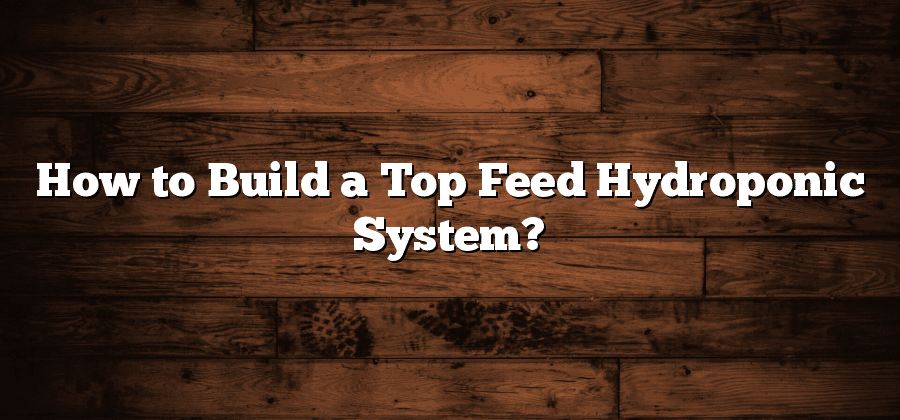Reservoir: The foundation of a top feed hydroponic system.
The reservoir plays a crucial role in a top feed hydroponic system. It serves as the foundation and main storage for the nutrient solution that will nourish the plants. Choosing the right reservoir size is essential to ensure a continuous supply of nutrients without interruptions. It is important to consider the number of plants, their growth stage, and the frequency of feeding when selecting the reservoir capacity. Additionally, the reservoir should be made from a material that is sturdy and non-reactive to prevent any contamination of the nutrient solution. Proper maintenance and regular checks on the reservoir are necessary to ensure the system’s functionality and the plants’ healthy growth.
Pump: The essential component responsible for circulating nutrient-rich water.
A crucial component in a top feed hydroponic system is the pump. This essential device is responsible for circulating the nutrient-rich water throughout the system, ensuring that plants receive the necessary nourishment for their growth and development. Without a properly functioning pump, the nutrient solution would remain stagnant, leading to inadequate distribution and potentially causing nutrient deficiencies in the plants.
The pump is designed to create a continuous flow of water, delivering it to the growing trays where the plants’ roots can absorb the nutrients. By circulating the water, the pump helps to oxygenate and aerate the nutrient solution, promoting healthy root development and preventing the buildup of harmful pathogens. Additionally, the pump facilitates the removal of any excess moisture from the system, preventing waterlogging and maintaining optimal moisture levels for the plants.
In summary, the pump is an indispensable component of a top feed hydroponic system. Its role in circulating nutrient-rich water ensures that plants receive the nourishment they need for optimal growth and health. Proper maintenance and regular monitoring of the pump are essential to ensure its efficient operation and the overall success of the hydroponic system.
Timer: An integral part to control the pump’s operation and ensure proper feeding intervals.
Timers are an essential component of any top feed hydroponic system, responsible for managing the operation of the pump and maintaining proper feeding intervals. These devices play a crucial role in controlling the timing and duration of nutrient solution delivery to the plants’ root zone, ensuring they receive the necessary nourishment at regular intervals. By carefully regulating the pump’s operation, timers help prevent overfeeding or underfeeding, ultimately contributing to the overall health and growth of the plants.
The main function of a timer in a hydroponic system is to automate nutrient solution delivery, eliminating the need for manual intervention. With precise programming capabilities, timers allow growers to establish feeding schedules that align with the specific requirements of their plants. By controlling the pump’s on and off cycles, timers ensure that the plants are receiving a consistent supply of nutrients, promoting healthy root development and optimal nutrient uptake. Additionally, timers help optimize water usage and reduce wastage by preventing the continuous circulation of nutrient solution when it is not needed.
Delivery System: The mechanism that delivers nutrient solution to the plants’ root zone.
The delivery system is a crucial element in any hydroponic setup as it is responsible for delivering the nutrient solution directly to the plants’ root zone. This mechanism ensures that the plants receive the necessary nutrients they need for healthy growth and development. By delivering the nutrient solution directly to the roots, the delivery system eliminates the need for the plants to search and compete for nutrients in the surrounding medium.
There are several types of delivery systems available, ranging from simple to more advanced designs. The selection of the delivery system depends on factors such as the size of the hydroponic system, the type of plants being grown, and the specific needs of the plants. Some common examples of delivery systems include drip irrigation, nutrient film technique (NFT), and ebb and flow systems. Each system has its advantages and disadvantages, and it is important to choose the right one for your specific setup and requirements.
Growing Trays: The containers where the plants are placed and nourished.
Growing trays are an essential component of a hydroponic system, providing a stable and controlled environment for plants to grow and thrive. These trays serve as the containers where plants are placed, allowing for easy access and maintenance. Designed with efficiency in mind, growing trays are typically made from durable materials such as plastic or fiberglass to ensure longevity and resistance against water and nutrient solutions.
The primary function of growing trays is to hold the growing medium and provide support for the plants. The growing medium, which can vary from peat moss and coco coir to perlite and vermiculite, helps anchor the plants’ roots while retaining moisture and nutrients. By carefully choosing the appropriate growing medium and adjusting the tray’s depth, hydroponic growers can create optimal conditions for the plants’ root development, leading to healthier and more productive growth. Additionally, growing trays often feature drainage holes to prevent waterlogged roots, promoting adequate oxygenation and preventing the risk of root rot.






